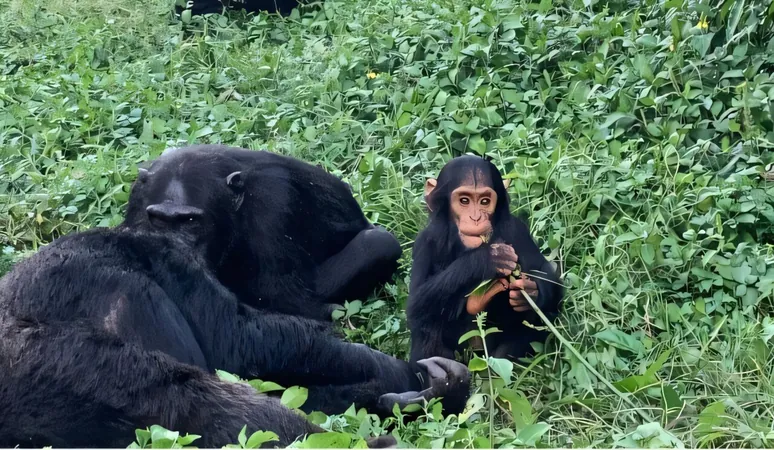
Unveiling Our Inner Gossip: How Chimpanzees and Kids Share a Fascination with Others
2025-06-23
Author: Sophie
Ever catch yourself people-watching at a cafe or binging on reality TV just to see who’s clashing with who? Don’t worry, you’re not alone! You might be surprised to learn that your inquisitive nature is remarkably similar to that of chimpanzees.
A groundbreaking study, recently highlighted in the *Proceedings of the Royal Society B: Biological Sciences*, reveals that both children and chimpanzees possess a strong desire to observe social interactions, even if it comes with a sacrifice. This study challenges the notion that social curiosity is solely a human trait; it appears to be shared with our closest primate relatives.
Lead researcher, Dr. Laura Simone Lewis from the University of California, Santa Barbara, shared, "Years of observing children and chimpanzees interrupting research games to peek at their peers inspired us to dive into this emerging field of curiosity research." Previously, social curiosity—defined as the desire to understand the actions, relationships, and emotions of others—remained largely unexplored.
The findings indicate that both young children and male chimpanzees actively prefer videos showcasing social interactions over those showing solitary individuals. In fact, some children and chimps were willing to give up rewards—jackfruit seeds for chimps and marbles for kids—just for the chance to witness social exchanges.
Dr. Lewis posits, "This underscores that social curiosity develops early in life, reflecting our evolutionary ties with chimpanzees. Our fascination with the lives of others—think gossip columns and celebrity dramas—has deep-rooted origins in our shared ape ancestry."
The research involved three cleverly designed experiments conducted at the Ngamba Island Chimpanzee Sanctuary in Uganda and various locations in California, including the Oakland Zoo. Co-author Dr. Esther Herrmann from the University of Portsmouth, remarked, "This study reveals that our desire to know what others are doing—what some might call being nosy—starts young and runs deep. It likely plays a crucial role in survival within complex social structures, benefiting both humans and our primate cousins."
The Experiments: A Peek into Curiosity
To explore this social curiosity, the researchers created two innovative "curiosity boxes"—wooden structures housing tablets that played different types of videos. In each experiment, both chimpanzees and children aged 4 to 6 had the choice between watching social interactions (like grooming or playing) or videos featuring a single individual.
The first experiment showed both chimpanzees and children gravitating towards the social scenes consistently. The second experiment posed a more challenging choice, offering a reward versus the opportunity to watch a social video. Many, particularly younger children and male chimps, opted for the video, showcasing their prioritization of social insight over immediate gratification.
The final experiment delved deeper, examining preferences for positive (grooming, playing) versus negative (conflicts) interactions. While chimpanzees exhibited no strong preference, human boys increasingly leaned towards negative interactions as they aged, whereas girls showed a preference for the positive.
Significantly, this study stands among the first to explore social curiosity directly across both species with the same methodologies, suggesting that our communal interest in social dynamics, who’s getting along, who’s not, and who’s worthy of our attention, links back to a common ancestor millions of years prior.
Moreover, this curiosity serves more than just entertainment; it aids in understanding relationships, navigating social dilemmas, and discerning trustworthiness. Dr. Herrmann concludes, "This kind of social curiosity is vital for learning about our surroundings, making choices, and nurturing relationships."









 Brasil (PT)
Brasil (PT)
 Canada (EN)
Canada (EN)
 Chile (ES)
Chile (ES)
 Česko (CS)
Česko (CS)
 대한민국 (KO)
대한민국 (KO)
 España (ES)
España (ES)
 France (FR)
France (FR)
 Hong Kong (EN)
Hong Kong (EN)
 Italia (IT)
Italia (IT)
 日本 (JA)
日本 (JA)
 Magyarország (HU)
Magyarország (HU)
 Norge (NO)
Norge (NO)
 Polska (PL)
Polska (PL)
 Schweiz (DE)
Schweiz (DE)
 Singapore (EN)
Singapore (EN)
 Sverige (SV)
Sverige (SV)
 Suomi (FI)
Suomi (FI)
 Türkiye (TR)
Türkiye (TR)
 الإمارات العربية المتحدة (AR)
الإمارات العربية المتحدة (AR)